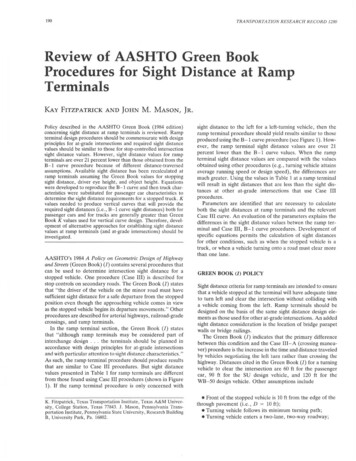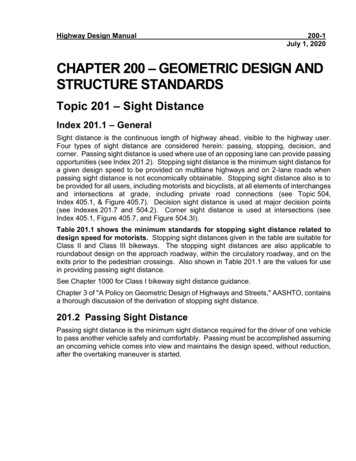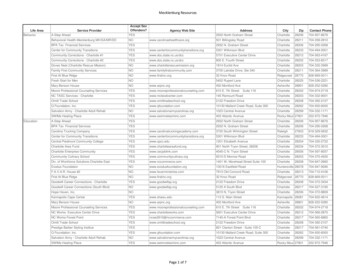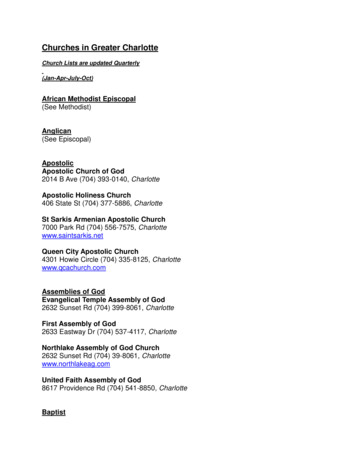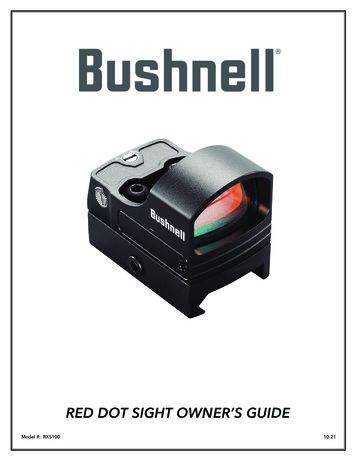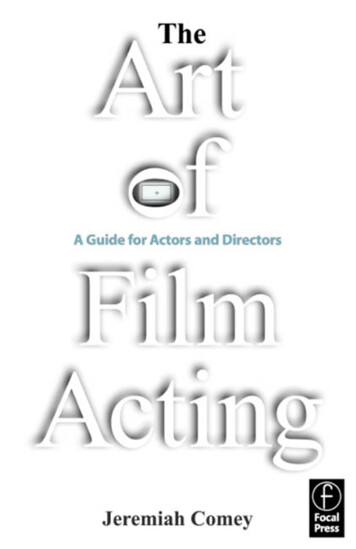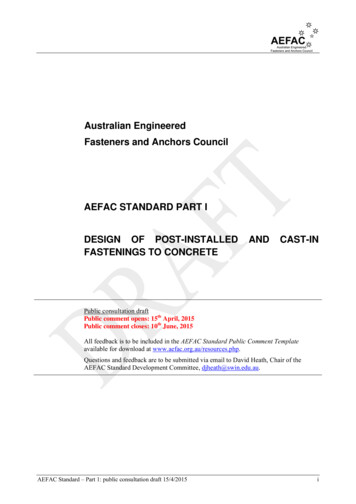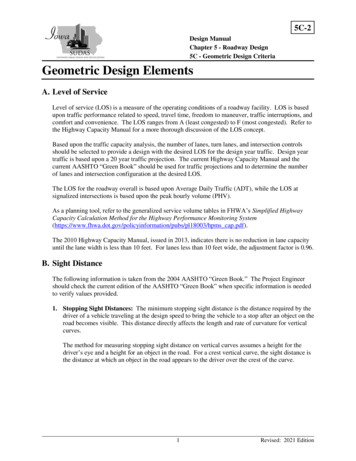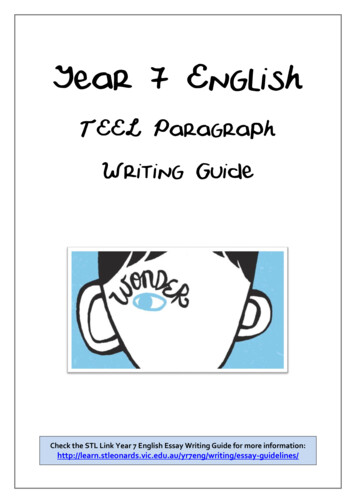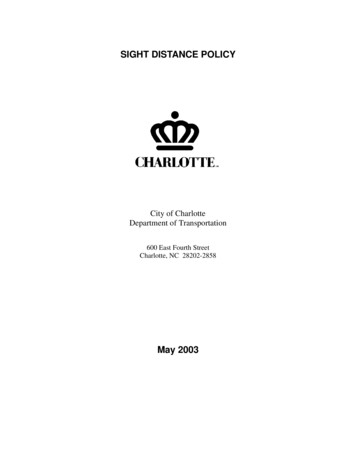
Transcription
SIGHT DISTANCE POLICYCity of CharlotteDepartment of Transportation600 East Fourth StreetCharlotte, NC 28202-2858May 2003
I.DEFINITIONSAASHTO: American Association of State Highway and Transportation OfficialsArterial Street: Controlled-access, major-, and minor Thoroughfares as identified in theMecklenburg-Union MPO’s Thoroughfare Plan.CDOT: City of Charlotte Department of TransportationCity: City of Charlotte, North CarolinaCity Code: Code of the City of Charlotte, North Carolina, latest revisionCollector Street: A street that collects and distributes traffic between local streets and arterialstreets as identified by the City of Charlotte. Generally speaking, collector streets funnel localtraffic onto thoroughfares and provide conveyance for through traffic.Cross Street: A street intersecting the one on which a driver is presently on. No inference ofright-of-way should be made from the term “cross street,” and the term should just be a synonymfor “intersecting street.” A cross street may be a Major Street or a Minor Street (q.v.).Design speed: The maximum safe speed that can be maintained over a specified section ofroadway when conditions are so favorable that the design features of the roadway govern. Forposted speeds of 30 MPH or less, the design speed shall be no less than the posted speed plus10%; for posted speeds of 35 MPH or more, the design speed shall be no less than the postedspeed plus 5 MPH.Director, Department of Transportation: The Director of the Charlotte, North CarolinaDepartment of Transportation or his designee.Director of Transportation: See Director, Department of TransportationDriver: Operator of a motor vehicleDriver’s Eye Height: The distance from the pavement surface to the driver’s eye.ETJ: Extraterritorial jurisdiction. Land outside the city limits of Charlotte that falls under Cityzoning and regulatory control.Existing Features: Any existing objects that are not built or installed by a given project.Green Book: A Policy on Geometric Design of Highways and Streets, AASHTO, latest edition.Horizontal Alignment: Tangents and curves in the horizontal plane that define the location of thestreet.
Intersection: The location of a public street, private street, or driveway where it crosses or meetsa public street.Landscaping: Roadside and median improvements involving trees, bushes, shrubs, and otherplants; grading and mounding; and signs, fences, and decorative walls.Local Street: A street that serves the primary function of access to residential, industrial, orcommercial property. The object is to provide access to abutting properties and not be aconveyance for through traffic. Subordinate to all other street classifications.Major Street: Relative to a given street, one that is more important, has a higher volume,functional classification, design speed, right-of-way, or any combination of these. A major streetis typically an unimpeded through movement in an unsignalized intersection or a movement thatreceives a majority of the green time at a signalized intersection.Minor Street: The street in a given intersection that is required to yield the right-of-way,indicated by signs or traffic signals, to a second street. See Major Street.NCDOT: The North Carolina Department of Transportation.New Facility: A proposed roadway, bridge, culvert, or landscape project; major reconstruction ormajor widening project.Object Height: The distance from the roadway surface to the top of an object in the roadway.Operating Speed: The 85th percentile speed or the posted speed limit, whichever is higher.Private Street: A street that is located on private property and that is not maintained by agovernment agency. Also, streets with rights-of-ways that have been dedicated to the public buthave not been accepted for maintenance.Public Street: A street that is located on right-of-way dedicated to the public and that has beenaccepted by the City of Charlotte or NCDOT for maintenance.Right-of-way: (1) The legal authority to construct a transportation conveyance across property.(2) The precedence of who yields to whom in a given circumstance, such as at an intersection.Side Street: See Cross Street.Sight Distance: The length of roadway visible to the driver who is traveling along the roadway orwaiting to enter or cross the roadway.Sight Obstruction: Any object that limits the view of the driver.
Sight Triangle: (1) An area formed by the curb lines or edges of the roadway and a straight linefrom the driver’s eye on one street to an object on the other street. (2) An area formed bymeasuring along the right-of-way or curb lines from their projected point of intersection back acertain distance from the intersection along two legs of the intersection and a straight linebetween the end points thus established.State System Street: Any street, road, or highway that is maintained by the North CarolinaDepartment of Transportation.Thoroughfare: A street whose main function is to provide mobility to the traveling public, i.e.,through traffic. Providing access to abutting properties is a secondary concern. Allthoroughfares are identified on the Mecklenburg-Union MPO’s Thoroughfare Plan.Through Street: See Major Street.Type I & II Driveways: A ramp-type driveway. (See City of Charlotte Driveway Regulations.)Type III Driveway: A street-type driveway. (See City of Charlotte Driveway Regulations.)Vertical Profile: Tangents and curves in the vertical plane that define the elevations andalignment of the roadway.II.SIGHT DISTANCE PRINCIPLES“The ability to see ahead is of the utmost importance in the safe and efficient operation of avehicle on a street. For safety on streets the designer must provide sight distance of sufficientlength that drivers can control the operation of their vehicles to avoid striking an unexpectedobject on the traveled way. “1 “The operator of a vehicle approaching an intersection at-gradeshould have an unobstructed view of the entire intersection and sufficient lengths of theintersecting street to permit control of the vehicle to avoid collisions. After a vehicle hasstopped at an intersection, the driver must have sufficient sight distance to make a safe departurethrough the intersection area”. 2III.APPLICATIONSight distance is the length of roadway visible to the driver who is traveling along the roadwayor who is waiting to enter or cross the roadway. Types of sight distance include, but are notlimited to, stopping sight distance, intersection sight distance, and passing sight distance. Thehorizontal alignment and vertical profile of a roadway affect sight distance. Objects such asbuildings, walls, parked cars, cut or fill slopes, trees, bushes, hedges, tall crops, signs, and otherobjects within and outside of the right-of-way can also affect sight distance. Some objects maybe located within sight-distance areas and not significantly obstruct the required visibility of thedriver. The driver may be able to see over, under, or around some objects within sight distanceareas. Objects that may be required within sight distance areas, such as fire hydrants, utility
poles, and traffic control devices, shall be located so that they minimize visual obstruction.Other objects 12 inches in diameter and smaller (including tree trunks and sign posts) may beallowed within sight distance areas if located individually or in combination so as not tosubstantially restrict the driver’s view. The Director of Transportation shall determine whatobjects, if any, are allowed within sight-distance triangles.The Director of Transportation has the overall responsibility for the improvement, operation, andmaintenance of Charlotte’s street system. Included in this responsibility are the evaluation,prevention, and abatement of obstructions to the view of motorists using any street or approachto any street intersection that may constitute a traffic hazard or a condition dangerous to thepublic safety. The AASHTO Green Book provides guidelines for designing sight distance fornew facilities and reconstruction projects. These guidelines may also be used to evaluate sightdistance obstructions along existing roadways. Existing conditions that obstruct sight distance atintersection can also be abated through section 19-245 of City Code.The Director of Transportation has developed this Sight Distance Policy to aid in the evaluationof public safety in and adjacent to the public right-of-way within the City of Charlotte and itsETJ. This policy regulates design of new roadways and reconstruction of existing roadways.The policy also applies to roadway designs within Charlotte or its ETJ constructed by privatedevelopers who intend to dedicate roadways and roadway improvements to the City or State forpublic maintenance. It also applies to landscape improvements adjacent to new and existingroadways.This policy should not be applied without qualification to existing conditions. To the extentdeemed possible by the City, existing facilities will be required to match these requirements.The sight distance requirements presented in this policy are minimum requirements and shouldbe increased where social, economic, and environmental considerations allow.It is recognized that certain improvements financed partially or wholly with State or Federalfunds or on facilities that fall under the jurisdiction of other governmental agencies are subject tothe standards prescribed by those agencies. Such standards may be more stringent than the Cityof Charlotte standards, and may take priority over City standards. In all cases, the morerestrictive of any two conflicting standards shall apply.IV.INTERSECTION-APPROACH SIGHT TRIANGLESSection 19-245 of City Code establishes two sight triangles that must be preserved at each publicor private street intersection with another public street, or at a Type III driveway connection to apublic street. These triangles measure 35’ x 35’, measured along the intersection of the rightsof-way, or 50’ x 50’, measured from the midpoint of the curb return along the face of curb. Themore restrictive of the two sight triangles shall be shown. These sight triangles shall bepreserved and reserved at all intersections as described above and are required to be shown on allapplicable plans. Smaller sight triangles, to allow drivers to see pedestrians on sidewalks,measure 10’ x 10’ and are required at all driveways regardless of type or intersecting streetclassification. They are oriented similarly to the 35’ x 35’ triangles.
These sight triangles provide drivers the ability to perceive an upcoming intersection, see if thereis any conflicting traffic, and take evasive action if necessary. These sight triangles are forapproaches to intersections and are separate entities from departure sight triangles (“intersectionsight distance”) mentioned later in this document.The NCDOT imposes a third sight triangle, measuring 10’ x 70’ in size along the intersectingrights-of-way, with the 70-foot dimension along the cross street. This sight triangle must beshown at all connections to a state-maintained roadway, regardless of street or drivewayclassification or dimension, and is located on each side of the approaching street or driveway.No object that impedes sight distance between a height of 30 and 72 inches above the groundsurface, subject to the exceptions established in Section III, shall be located within any of thesethree sight triangles.The City of Charlotte Zoning Ordinance exempts certain zoning districts from mandatory use ofthe 35’ x 35’ or 50’ x 50’ sight triangles. In these areas, the Director of Transportation willestablish any necessary sight triangle(s) on a case-by-case basis. NCDOT 10’ x 70’ trianglesshall apply regardless of zoning district unless specifically exempted by NCDOT.V.STOPPING SIGHT DISTANCEStopping sight distance is defined as the amount of distance required for a driver to perceive anapproaching hazard, evaluate the hazard, apply the brakes, and comfortably bring his car to acomplete stop without colliding with the hazard. The minimum stopping sight distance must beavailable to the driver at all locations on publicly-traveled ways. Stopping sight distance appliesto horizontal as well as vertical alignments. Stopping sight distance on horizontal curves ismeasured along the centerline of the inside lane around the curve and the line of sight is astraight line between two points on the centerline of the lane. On vertical curves, stopping sightdistance is measured on a straight line between the driver’s eye and an object on the roadwaysurface. The height of the driver’s eye traveling in a passenger car shall be measured at 3.5 feetabove the roadway surface and the object shall be 2.0 feet above the roadway surface. Driver’seye heights for single-unit and tractor-trailer trucks shall be measured at 7.6 feet above theroadway surface. The object height has been increased in the 2001 Green Book from the 0.5 feet(6 inches) used in the 1990/1994 Green Books. Figures 1 and 2 illustrate that measurement ofstopping sight distance horizontally and vertically, respectively. A more detailed explanation ofthe measurement of stopping sight distance is included in the Green Book. The minimumstopping sight distance required is based on wet pavements and depends on the design speed andthe grade of the roadway. Table I presents the minimum stopping sight distances for variousdesign speeds on level terrain. Table II presents stopping sight distance requirements that havebeen adjusted for grades; for grades not listed in the table, linear interpolation can be used todetermine the appropriate value.New streets or driveways that fail to provide adequate stopping sight distance will not beapproved. Proposed subdivisions must provide full stopping sight distance on all internal streets.
Streets whose geometry causes the line-of-sight for stopping sight distance to extend outside theright-of-way will require sight-distance easements for the balance or their alignments must berevised to provide the sight distance.TABLE I.Minimum Stopping Sight Distance For Level Conditions for passenger cars(Exhibit 9-55, p.665, 2001 Green Book)Design Speed (MPH)1520253035404550556065Minimum Stopping Sight Distance (ft.)80115155200250305360425495570645TABLE II.Stopping Sight Distance on Grades for passenger cars(Exhibit 3-2, p.115, 2001 Green 3400474553638728(Speeds are in MPH and distances are in feet.)SSD:-9%85126173227287354427507593686785SSD: 3%75109147200237289344405469538612SSD: 6%74107143184229278331388450515584SSD: 9%73104140179222269320375433495561
VI.INTERSECTION SIGHT DISTANCE“Each intersection contains several potential vehicle conflicts. The possibility of these conflictsactually occurring can be greatly reduced through the provisions of proper sight distances ” 3Intersection sight distance allows a driver to observe a gap in traffic, evaluate its size andapproach rate, and cross and/or merge into the gap, usually from a stopped condition.Along the approaches and departures from an at-grade intersection, there must be sufficient sightdistance for the operator of a vehicle to control the vehicle to avoid collisions. The amount ofsight distance required depends on the type of traffic control at the intersection and the speeds ofthe vehicles.Intersection sight distance is measured from a driver’s eye height of 3.5 feet to an object heightof 3.5 feet as measured from the pavement surface. The object height has been decreased in the2001 Green Book from the 4.25 feet used in the 1990/1994 Green Books. Driver’s-eye heightsfor single-unit and tractor-trailer trucks shall be measured at 7.6 feet above the roadway surface.Where proper sight distance cannot be achieved for the driver on the side street at the designspeed of the intersecting roadway, CDOT shall determine an appropriate alternative, including,but not limited to, posting a speed reduction on the through street, landscape improvements, oraltogether prohibiting the street- or driveway connection to the through street. All streets that arebeing designed as part of one contiguous development, such as a subdivision, shall provideappropriate intersection and stopping sight distances in all cases. Because the streets are beingdesigned and are not already-existing streets, it is incumbent upon the developer and hisconsultant(s) to submit a development plan that satisfies all sight-distance requirements. Phasinga development such that only portions are built at any one given time does not eliminate therequirement to provide sight distance.A. Yield Sign ControlThis type of design requires that the minor street be posted with yield signs. The sight distancefor the driver on the minor street must be sufficient for the driver to observe a vehicle on thethrough street approaching from either the left or the right and bring his vehicle to a stop prior toreaching the intersection as shown in Figure 3. The assumed design speed approaching the yieldsign is 16.5 mph, resulting in a stopping sight distance of 80 feet and an intersection sightdistance of 180 feet. For cases where the design speed is greater than 16.5 mph (i.e., a postedspeed of 15 mph), see Exhibit 9-64 of the 2001 Green Book. The table in Exhibit 9-64 assumescertain conditions; for conditions that differ from these assumptions (see Condition VI.E,“General Case”), the sight distance must be evaluated per pp. 670-672 of the 2001 Green Book.
B. Stop Sign ControlAt approaches to intersections that are controlled by stop signs or at driveways and alleys wherethe driver is required to stop before entering the street by the City Code, the driver must have anunobstructed view of the entire intersection and adequate sight distance for any of the variousvehicular movements allowed upon departure of the intersection. These movements may includecrossing the street, turning left, or turning right onto the street. Where the through street is eitherundivided or divided with a median narrower than 20 feet, the crossing or left-turn movementsare treated as a single operation. Where the median can provide storage for the design vehicle(20 feet wide for a passenger car), the crossing or left-turn movement can be considered in twophases.No obstruction to the driver’s view shall be located within the sight triangles as defined in theCity Code, Section 19-245 (a) through (d), to permit adequate view of the intersection (SeeFigures 4 and 5). In addition, there shall be no sight obstructions located in the triangular areasshown in Figures 6 through 8 to allow for safe departure through the intersection. Themeasurement of intersection sight distance is along the centerline of the appropriate lane of theroadway and is measured from an eye height of 3.5 feet above the surface of the roadway to anobject 3.5 feet above the surface of the roadway. The location of the driver’s eye (D1) isdependent on the classification of the intersecting streets. For all intersections where the throughstreet is a thoroughfare, the driver’s eye location shall be assumed to be 15 feet back from theface of curb extended through the intersection, or the edge of pavement if there is no curb. At allintersections where the through street is a local or collector street, and for Type I and IIdriveways, the driver’s eye shall be assumed to be located 10 feet behind the face of curbextended, or the edge of pavement if there is no curb. The sight distance lengths D2 and D3shown in Figures 6 through 8 for left- or right-turns onto the through street are dependent an thedesign speed of the roadway and are presented in Table III. Figure 9 shows the measurementmethod for determining the sight distance-for left-turns from the through street. Table IV givesthe minimum sight distance for this movement across one, two, or three lanes (D1).For all-way stop-controlled intersections, only the required approach sight triangles must beprovided. If, however, an all-way stop-controlled intersection may become signalized in thefuture, treat the intersection as if it were signalized (see next section).C. Traffic Signal ControlFull intersection sight distance for the stop-sign-controlled condition shall be provided at allsignal-controlled intersections as well. The sight distance shall be provided to accommodate (1)left- or right-turns on red, and (2) conditions when the signal is operating in flash mode.
TABLE III.Intersection Sight Distance for stop-sign and signal-controlled intersections for passenger cars(Exhibits 9-55 and 9-58, 2001 Green Book)Design Speed (MPH)1520253035404550556065Minimum Intersection SightDistance for Left-turn fromStop (ft.)170225280335390445500555610665720Minimum IntersectionSight Distance for RightTurns and Crossing (ft.)145195240290335385430480530575625It is recommended that the amount of Intersection Sight Distance necessary to permit a left turnfrom a stop condition also be the design sight distance for the right-turn and crossing conditions.D. Left turns from the through streetDrivers making left turns from through streets onto cross streets must be able to judge anadequate gap in oncoming traffic, accelerate from a complete stop, and exit the roadway. Ontangent horizontal alignments with intersecting streets, the stop-controlled intersection sightdistance parameter (See Condition V.B) will likely govern and provide sufficient sight distanceto perform the left-turn from the major road maneuver. However, in curved horizontalalignments, especially on median-divided roadways, the left-turn from the major road conditioncan be a separate, and possibly more restrictive, requirement. The designer should notautomatically assume that this requirement is superseded by a stop-controlled requirement andshould evaluate this case separately. Exhibit 9-67 on page 679 of the 2001 Green Book listsminimum sight distances needed to make a left turn across one lane of traffic on an undividedroad (this left turn could be made from a through lane or an exclusive left-turn lane). Forconditions where having to cross a median or more lanes, and/or where grade is an issue, thesight distances must be adjusted per the instructions on page 678 of the 2001 Green Book.E. General CaseIn all cases, intersection sight distance is a multi-variable parameter. Intersection sight distanceis a function of the intersecting-street cross-section, intersecting street approach grade, minorstreet approach grade, design vehicle, and intersecting street laneage. The Green Book listsdefault values of intersection sight distance but states that it must be calculated on a case-by-case
basis if any of the parameters listed above does not fall within a default range. The necessaryformulas and adjustment factors for non-default values may be found on pp. 660-670 of the 2001Green Book for stop-controlled intersections, pp. 670-672 for yield-controlled intersections, andpp. 678-680 for left turns from through streets. The default/assumed values for these parametersare as follows:1.2.3.4.5.-3.0% to 3.0% through street approach grade0.0% minor street (the street that stops/yields) approach gradeTwo-lane through streetUndivided through streetPassenger car design vehicleVII. EXISTING CONDITIONS AT PUBLIC STREETS ANDINTERSECTIONSThe Director of Transportation has the responsibility to evaluate, prevent, and abate obstructionsto the view of motorists using any street or approach to any street intersection so as to constitutea traffic hazard or a condition dangerous to the public safety according to Section 19-245(g) ofthe City Code. The Code sets forth restrictions on objects and combinations of objects thatobstruct the view of motorists in the triangles of land shown in Figures 4 and 5 of this policy andin any other location on public or private property that constitutes a condition dangerous to thepublic safety. The Code further provides for notification and enforcement of violations.The evaluation of adequate provision of sight distance shall generally conform to therequirements set forth in this policy. It is recognized that in some cases existing conditions mayexist that prevent the attainment of desirable sight distance due to social, economic, orenvironmental considerations. In these cases, the maximum practical sight distance, up to thedesirable values, shall be obtained. In addition, where desirable sight distance is not attained,additional measures such as warning signs, reduced speed zones, and other traffic controls maybe imposed. In all cases, except those specifically exempted in City Code, the minimumprovision of adequate stopping sight distance shall be required.VIII. PASSING SIGHT DISTANCEIn general, crossing the centerline of the road to pass another vehicle is not allowed within thecity limits. If passing zones are established on city streets, the Director of Transportation willestablish the required amount of passing sight distance, which shall be no less than what isrequired in the Green Book. On State-maintained roadways, the Director of Transportation andthe North Carolina Department of Transportation will establish the required passing sightdistance.
IX. ON-STREET PARALLEL PARKINGExcept where specifically authorized by the Director of Transportation, all on-street parallelparking shall recessed such that through lanes are unimpeded. No parallel parking can occurwithin 20 feet of intersections with driveways and local or collector streets, and 50 feet forthoroughfares. The amounts of sight distance necessary shall be evaluated on a case-by-casebasis; a more restrictive condition than the 20- or 50-foot distance listed above may be imposedat CDOT’s discretion.On-street parallel parking should be located adjacent to and outside of a 35’ x 35’ or 50’ x 50’sight triangle.On-street parallel parking is prohibited on NCDOT-maintained roadways unless specificallyauthorized by NCDOT.
FOOTNOTES1. A Policy on Geometric Design of Highways and Streets, Washington, DC, AASHTO, 1990, p. 1172. Ibid, pp. 739, 740.3. Ibid, p. 739.
Green Book: A Policy on Geometric Design of Highways and Streets, AASHTO, latest edition. . State System Street: Any street, road, or highway that is maintained by the North Carolina Department of Transportation. Thoroughfare: A street whose main function is to provide mobility to the traveling public, i.e., . object on the traveled way. .


